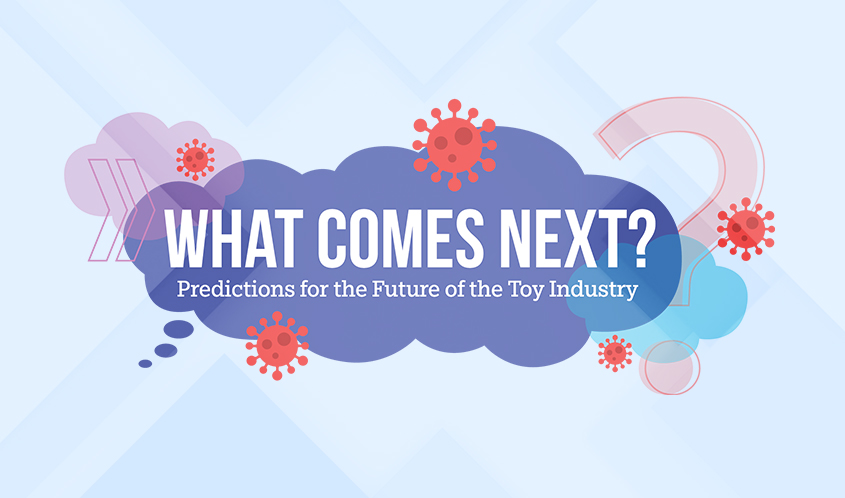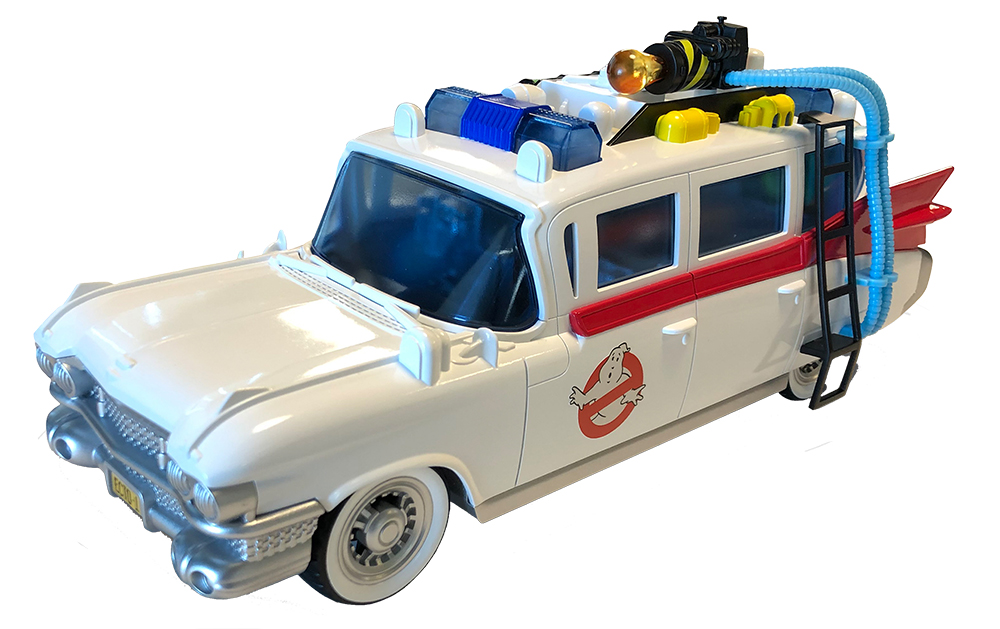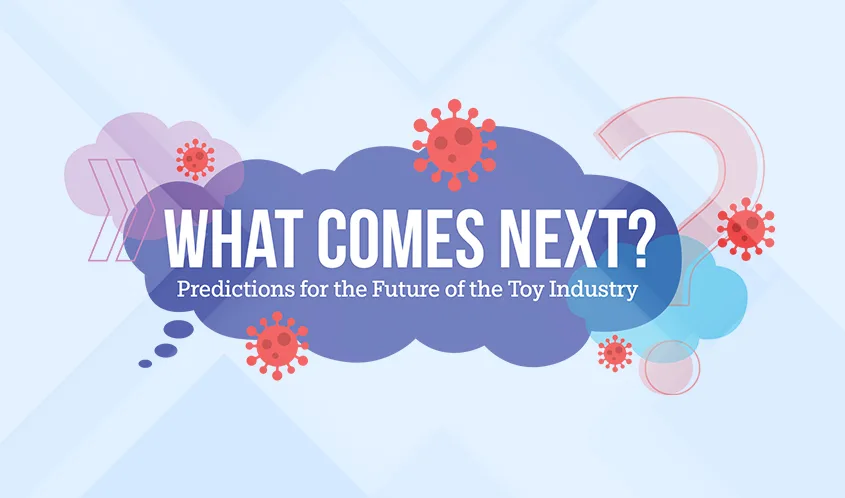[et_pb_section admin_label=”section”]
[et_pb_row admin_label=”row”]
[et_pb_column type=”4_4″]
[et_pb_text admin_label=”Text”]

by Sean McGowan, managing director, Gateway Investor Relations
Of all the comparisons I read regarding what 2020 will be remembered for, the one I found most useful is 1918+1929+1968=2020.
This year, we’ve experienced a lethal pandemic, an economic collapse, and an explosion of social unrest. I will let the historians of the future debate whether all three of these conditions in 2020 were rooted in COVID-19, but there is no doubt that the effects of this confluence are being felt around the world, by every citizen and every segment of the economy in every country. So, against this backdrop, what has changed in the toy industry? Well, pretty much everything.
The last time the economy suffered a massive sudden collapse was in 2008, and we all asked ourselves then: “How much of what has been changed by the Great Recession will remain, and how much will go back to ‘normal?’” In fact, most of us speculated on what would be the “new normal.” One conjecture, for example, was that even people who did not lose their jobs would realize how little they actually needed to spend to get by, and, therefore, remain permanently more frugal than they had been before the shock. But, we now know that most folks eventually went back to old habits.
And this time, it feels a bit different. It’s clear that the pandemic has caused a lot of major near-term changes, and I think some of these changes will linger. Others will not only linger but give rise to — or at least accelerate — some other changes indirectly related to COVID-19.
NEAR-TERM EFFECTS
It certainly has been a tough year, and it seems increasingly likely that the recovery isn’t going to have a V-shape. (In fact, it’s not even clear when we hit the trough, or how long it will take us to realize it’s been hit.) Supply chains were disrupted early on, and while most are greatly improved, there are still disruptions. Sell-in of toys in most categories was massively down in the first half of the year, and the costs of dealing with the disruptions have kept companies’ cost structures high. Unless, of course, they have let employees go, which, unfortunately, many companies have.
Some of the downsizing might fall under the heading “Never Waste a Good Crisis.” There are always savings to be found, and an economic pullback makes cost-cutting feel less out of place, but our industry is seeing reductions that go way beyond tweaking and pruning.
Consumer demand for toys has been quite strong through the first six months of the pandemic, driven in part by the need to keep kids occupied while they are suddenly stuck at home, and because toy sales are typically resilient to macro-economic downturns. But because retailers have never faced an environment like this one, they were naturally reticent about taking in more inventory in the first half of the year. As a result, retail inventories of toys are quite low. It’s not clear at this time how consumer demand, retailers’ orders, and manufacturers’ willingness to build their inventories will align for the balance of the year, so we may be looking at a tough year for toy sales no matter the status of the pandemic.
Even before we get to the holidays, of course, we have a few other hurdles and waypoints to clear. “Back to school” meant something different depending on who you talked to. It was not a clear sales event. Toy Fair Dallas was canceled, and Halloween was in no way business as usual.

Even the usual flood of holiday films may be little more than a trickle this year, which means toys hoping to get a lift from a theatrical release (Ghostbusters: Afterlife, a couple of Marvel films, etc.) will have to wait a bit longer, and releases such as Mulan that have been moved to Disney+ did not draw the same size audience that was initially expected. As it happens, sales of figures and collectibles tied to entertainment content have lost ground to activity toys and games in recent months, and it’s not clear whether new film releases would have reversed that trend.
Another change we can expect to see in the near term is fewer events such as birthday parties, during which kids would receive some new toys. Surely that will return at some point, but not until parents feel safer having their children in groups, doing typical birthday party stuff like screaming and singing.
RELATED: Adapting Your Brand to Fit Kids’ New Routines
But one of the biggest near-term changes we’ve been experiencing over the last seven months has been the big swing to e-commerce. Even as stores have reopened, e-commerce remains strong at elevated levels. The habits of late-night shopaholics notwithstanding, shopping online tends to lead to less impulse buying as compared to walking through a store. Shopping has become more “mission-driven,” and that may last for a while. Plus, buy-online-pickup-in-store (BOPUS) options offered by many retailers has the same low-impulse effect. You’re at the store, in the parking lot, but you’re not dragging your kids in tow as they cry “Mommy, Daddy, I NEED this!”
LONG-TERM EFFECTS
Thinking a bit longer term, some changes wrought by COVID-19 may also endure well beyond the holiday season, and possibly well beyond the development of an effective vaccine. In my opinion, the economy won’t fully bounce back next year. Not all jobs will be restored, and those that are may pay less than what they paid before. Too many companies have suffered too much damage for the recovery to be complete in just a few months.
In addition, the idea of focusing on value takes center stage, even for those who haven’t lost jobs or faced pay cuts. Economic uncertainty breeds frugalness. Toys are resilient in economic downturns, but they are not immune.
On the positive side, low retail inventories we are likely to see going into next year should allow for increased shipments as stocks get replenished, but it will take some time. And, again, we may see consumer changes in shopping habits lingering longer, and there will be more concern about shopping in a clean, safe environment; more mission-driven shopping; and more parent-driven shopping. Also, if over the last seven months people have set up online accounts with retailers they had never shopped with before, they are more likely to continue shopping at those sites in the future.
One result of the accelerated shift to e-commerce could be a re-evaluation of packaging. So much of what toy packaging is about is making the product stand out on the shelves and cut through the noise. If the product has already been purchased by the time the shopper sees it or touches it, there is less need for such elaborate packaging. This was already true, and has been a talking point for sustainability proponents for some time. Similarly, if BOPUS continues to grow, do you even need to spend as much on in-store merchandising? Probably not.
The deferral of so many films into 2021 could create an overcrowded landscape for licensed goods. It’s not like nothing was planned for 2021 before the pandemic, and now the 2020 releases have been added to the mix for next year. If theatrical openings get stacked up, it could lead to a loss of mindshare if there are too many tentpole openings. Of course, with all that entertainment content, there should be a sharp increase in sales of figures and collectibles. But there might actually be too much content for them all to do well — it’s been known to happen.
And what might be the even longer-term lessons of 2020? Do we even need movie theaters anymore? We could see an acceleration of direct to streaming-video-on-demand (SVOD) releases, which has worked well for companies, including DreamWorks with Trolls: World Tour and Warner Bros. with SCOOB!
RELATED: Toy Fair New York Set to Return in May 2021
WHAT’S AHEAD FOR 2021?
It’s only been a little more than a half a year since Toy Fair New York in February, but the show has already been postponed to May 1-4 next year. We are tempted to think that 2022 will see a return to normal shows, but how certain is that? Back in February, would anyone have thought that next year’s shows would be shut down? And assuming the shows do return, will they ever be the same? It’s fair to assume many attendees are reevaluating the need to gather in large numbers with people from all over the world.
Beyond the end of 2021, it’s much harder to predict the lingering impact of COVID-19 on the toy industry, other than to have accelerated trends already in place. We’ll all probably go back to shaking hands, attending parties, and taking our kids to movie theaters at some point, but it might not be at the same levels. Of course, all of that assumes we get this thing under control. In the meantime, stay safe.
This article was originally published in the October 2020 edition of the Toy Book. Click here to read the full issue!
[/et_pb_text]
[/et_pb_column]
[/et_pb_row]
[/et_pb_section]


